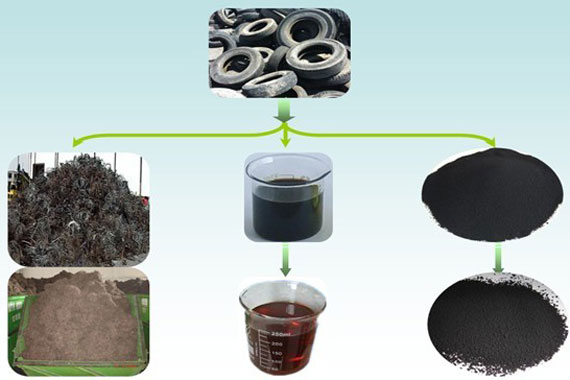The objective of the present study is to convert waste tyres catalytically at relatively low temperature into liquid hydrocarbons as well as to drive liquid in the boiling range of commercial fuel oil. The liquid obtained from catalytic pyrolysis of waste tyre rubber were characterized in terms of fuel characteristics, because the liquid derived is very complex and has fuel properties intermediates between those of a light fuel oil and gas oil. Important requirements for diesel fuel and other fuel oil are its ignition quality, viscosity and sulfur contents.

Effect of time on catalytic pyrolysis of waste tyre rubber
The effect of residence time on the catalytic high temperature pyrolysis of waste tyre rubber at optimum temperature and catalyst/feed ratio was investigated in the range of 30 to 180 minute. Due to different nature and properties of each catalyst, the time investigated for maximum conversion into liquid product is different. Maximum oil and the residue (carbon black) obtained at 60 minute pyrolysis time with CaC2 is 37.3±0.01 wt % and 33.5±0.1 wt % and with PbS is 37.0±0.1 wt % and 33.46±0.15 wt % respectively. The carbon black residue weight in both cases is almost equivalent to the theoretical weight of carbon black in tyre rubber, in case of MgO, maximum oil (44.53±0.50 wt %) obtained at 90 minute pyrokysis time with 37.13±0.76 wt % of residue. The yield of liquid with Al2O3 and SiO2 is also maximum at 90 minute time 34.13±0.23 wt % and 30.7±0.01 wt % respectively. The optimum catalytic pyrolysis time for CaCO3 is 120 minutes and 150 minutes for ZnO and SiO2-Al2O3. Higher yield of residue with SiO2 and SiO2-Al2O3 indicates incomplete tyre pyrolysis process.
Characterization of tyre pyrolysis liquids
The liquids obtained in waste tyre pyrolysis, which are usually termed oil, are dark-brown colored products. These liquids are a mixture of aromatic and aliphatic compounds. This logical because the main polymeric component of automotive tyre is styren – butadiene rubber (SBR), which has both aromatic structure (styrene – repetitive unit) and aliphatic structure (butadiene – repetitive unit).
the tyre liquids fraction except CaCO3 have more light products than the commercial diesel oil under 300℃, since for the same temperature a greater distillate volumes are obtained with the tyre liquid. This is an advantage that the product can be atomized better and therefore, it is possible to initiate the combustion at lower temperature.

